A Silk Road Alternative: The Ancient Tea Horse Route
Keith Lyons takes an alternative route through China, ditching the Silk Road for the ancient Tea Horse Road.
Shares
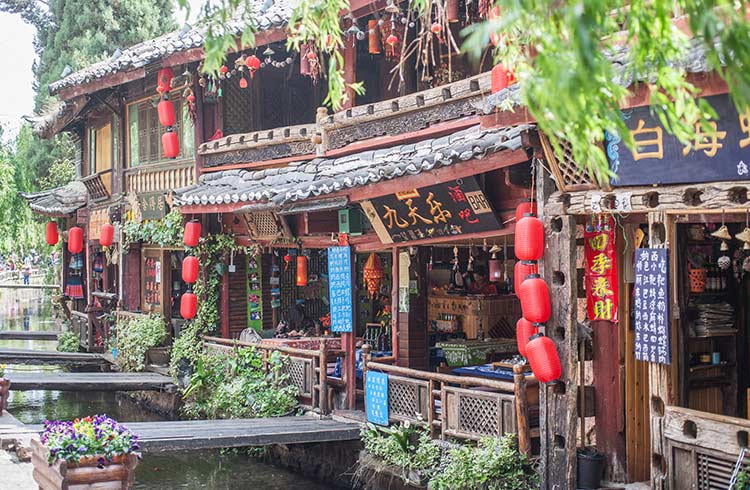 Photo © Getty Images/Buena Vista Images
Photo © Getty Images/Buena Vista Images
When the abbot of a Tibetan monastery in Sichuan showed me bricks of black tea stored in a kitchen pantry, it got me thinking about how the addictive substance, first introduced to Tibet in the 7th century, had long been transported over high passes to harsh places too cold to grow tea.
Taking inspiration from Super Size Me documentary-maker Morgan Spurlock, who had told me about hatching a ‘really great, bad idea’ as we snuck into a McDonald’s restaurant more than a dozen years ago, my ‘great, bad idea’ was to pick and process some tea from the original tea-growing region in southwest China, and take the fermented and compressed tea along the ancient Tea Horse Road – the Southern Silk Route – via the eastern Tibetan Himalayas, to one of the oldest teahouses in China.
Tea Horse Road
You will have heard of the historic Silk Road, the camel-train route linking the East and the West, where goods and ideas where exchanged between the 2nd and 14th centuries. Though less well-known, the Tea Horse Road – or Cha Ma Gu Dao – was active from the 7th century until the mid-20th century.
This Southern Silk Route was a network of trails more than 1,850mi (3,000km) in length, from tropical Yunnan in the south, through Tibet and on to India and beyond.
But the caravans of mules and yaks (and hardy porters carrying up to their own weight in loads) didn’t just transport blocks of tea, but also salt, silver and silk. One of its greatest deliveries was spreading Buddhism from India to the east.
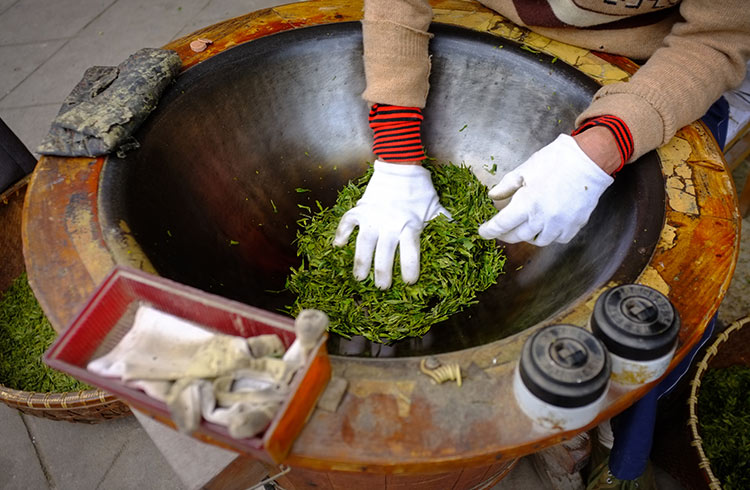
Jinghong
After an hour’s drive through foggy gloom, past endless rubber and banana plantations, from the Xishuangbanna city of Jinghong towards the Myanmar and Laos borders, I still can’t make out the telltale rows of contour-planted tea bushes.
I’m still baffled when the driver stops, points me towards a path in the mist, and taps out on his phone translator, ‘ancient tea gardens’. There, I am surprised to find a gnarly tree with large leaves, believed to be 800 years old: the king of the tea trees. Tea from this area, Nannuo, is now worth more than its weight in silver. Cuttings from trees in these Chinese borderlands spread tea cultivation to more than 50 countries.
But I can’t pick tea from this protected forest; instead we go to the driver’s Hani-minority hamlet, where I sweatily collect basketfuls of shiny, tender leaves from wild trees.
I spread out my tea on round trays to wilt and dry, while I am plied by the driver’s father with endless cups of bright orange tea, which is initially bitter, but has a honey aftertaste.
Later, the leaves are tossed into a giant wok, and the villagers set about rolling and shaping the leaves. The slightly bruised pan-roasted strands are finally left in the sun to dry. As I’m due to get on a night bus to Dali, in a ‘here’s-one-I-made-earlier’ moment, I’m given a bag of recently-dried loose tea which I’ll get made into ripe pu’er (pronounced ‘poo-erh’), as well as seven frisbee-rounds of tea (known as raw pu’er) bound in rice paper and wrapped in bamboo.
Dali
Putting the ‘travail’ in travel, it takes 15 hours to cover the 384mi (620km) distance by bus from muggy Jinghong to the fresh air of Dali, a change of 4,500ft (1,250m) in elevation. But I’m not exactly elated.
When I arrive in the trade crossroads of Dali city, I am as bruised and as dehydrated as my bulky bag of tea thanks to the bumpy night drive over roads under construction. Dali is famous for the 9th-century Three Pagodas and the Cangshan Mountains sitting above vast Erhai Lake. Not far from the backpacker haven of the Old Town, I hand my loose tea over to the boss of a tea factory, to be transformed into something more portable and less bitter by the process of accelerated fermentation and aging developed in the Dali area. My tea is added to a pile of leaves, which will be kept moist and warm. When should I come back? I ask. A couple of months, he replies.
When I do return, my precious tea has been reduced to what looks like compost. The dark material is carefully measured, then steamed, and finally pressed into a small convex dome. In this post-fermentation form, unlike green tea, this low-caffeine tea will get better – and more valuable – as it ages.
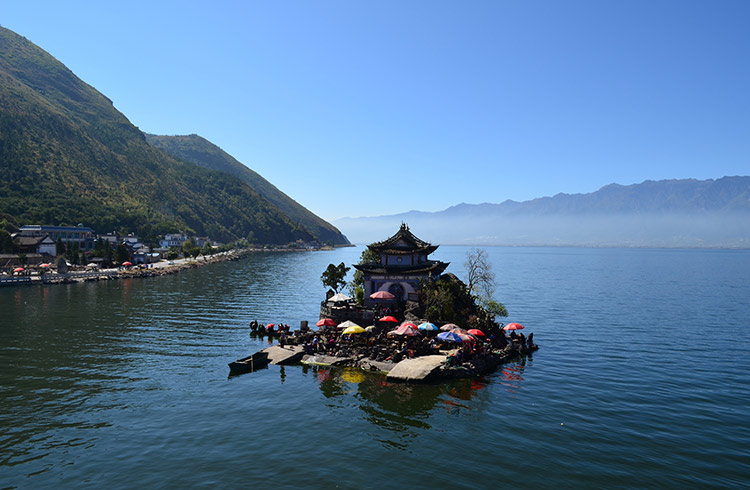
Shaxi
I take my domes of compressed tea from the tea growing and processing areas to the next major trade hub on the Tea Horse Road, hidden away a couple of hours north of Dali, via the main town of Jianchuan. As the minivan navigates the winding road, I catch glimpses of the patchwork fields as we descend into the so-called ‘last unspoilt valley in China’.
Later that balmy evening, I watch a caravan of mules, loaded with burlap sacks strapped to wooden saddles, clip-clop by on the cobblestones of Shaxi’s market square, and I think about what I might be able to trade my tea for.
Looking out through the coin-shaped, carved lattice screen windows – symbolizing prosperity – I’m reminded how this restored staging post is too cold to grow tea, so my goods should be more valuable here. “How about some medicinal plants,” suggests my Bai-minority food guide Li Han Mei (Apple), “Or matsutake mushrooms, if they are in season?”
After being lulled by the hypnotic sounds of a village orchestra at the Old Theater Inn, a converted theater and shrine, owner Chris suggests exchanging my tea for packhorse-couriered Mapingguan honey, or a local delicacy ham. “If you have enough tea, you might be able to get a small spotted heirloom pig.”
Instead, the next day I decide to give away some of my tea fortune. At a ramshackle Ouyang merchant courtyard, where some of the last muleteers once lived, I press a round of tea upon the historic building’s caretaker; and after much insistence, he accepts, only to load me up with pears for the trip onward and upward to Lijiang, only a couple of hours away by bus due to the new tunnel and bridge highway from Jianchuan.
Lijiang
The alleyway and bridge maze of the UNESCO World Heritage Old Town of Lijiang possibly has the highest density of tea merchants in China packed into its 3mi2 (8km2) unwalled ancient city. I search the stone and wood labyrinth for two things vital for making the perfect brew: one pricey, the other priceless.
Passing oxblood wooden paneled shopfronts, the weathered Big Stone Bridge, and the former Mufu Palace, I finally find a locally-made black clay teapot at the bustling Zhongyi Market.
I walk upstream from the town’s landmark water wheels to the picture-perfect Black Dragon Pool, where a five-arch bridge, pavilion and the distant 18,400 ft (5,600m) high Jade Dragon Snow Mountain are reflected in the pond. From an artesian aquifer, I fill two bottles with the glacial meltwater, wondering if Kublai Khan’s soldiers did the same in 1253, or if horsemen stopped here on their supply missions to Tibet and India during the Second Sino-Japanese War between 1937 to 1945.
Carrying my water, I am stopped by an old man who speaks to me first in Russian, then Mandarin. Qu Mao Hong, who was born in the 1940s, takes me up Lion Hill to see the remnants of the Tea Horse Road; the conglomerate stone worn down by shoes and hooves. In the distance, beyond the Jade Dragon Snow Mountain and Tiger Leaping Gorge, is my next destination, Shangri-la, the first Tibetan town on the way to Lhasa.

Shangri-la
In centuries past it took more than a week to get from from Lijiang to Shangri-la, via the Yangtze River crossing point at Shigu, but the road reduces the 124mi (200km) trip to less than four hours – and travel times will be halved when a new railway and highway is completed by 2021.
As we sit around the stove in the Tibetan Garden Inn, in Shangri-la’s old town – at 10,500 feet (3,200m) – my Tibetan host Bao, who got me hooked on the local way of drinking tea when I first stayed here more than a decade ago, asks the question he knows I can’t refuse. “Have some suyou cha (yak butter tea)?”
Fragments of my ripe pu’er tea have been added to a simmering kettle, and then the smoky, bitter brew is poured into a wooden cylindrical tube, and churned with a dollop of yak butter (from summer grasslands near his father’s village) and more than a pinch of salt.
“He likes Tibetan tea,” Bao proudly tells a couple visiting from Beijing. I slurp the salty, murky liquid from a wooden bowl, feeling the grease lining my gullet, as they look on in horror wondering how anyone could stomach tea that has been adulterated with fat and lactose. When my second bowl is partly finished, I do something else which confounds the tourists. Adding spoonfuls of roasted barley flour – called tsampa. I use my middle finger to combine it with the remaining yak butter tea, rotating the bowl as Bao has shown me, and squeezing the crumbly mix into a pale brown-flecked solid oval. I sample the hand-kneaded ball. The slightly rancid taste of yak butter has gone; instead, the tsampa is nutty and malty, similar to hot milk on breakfast cereal.
“Hao chi ma? (tastes okay?),” the Beijing man, suddenly even more pale-looking, asks hesitantly. “Fei chang hao chi (unusually delicious),” I reply.
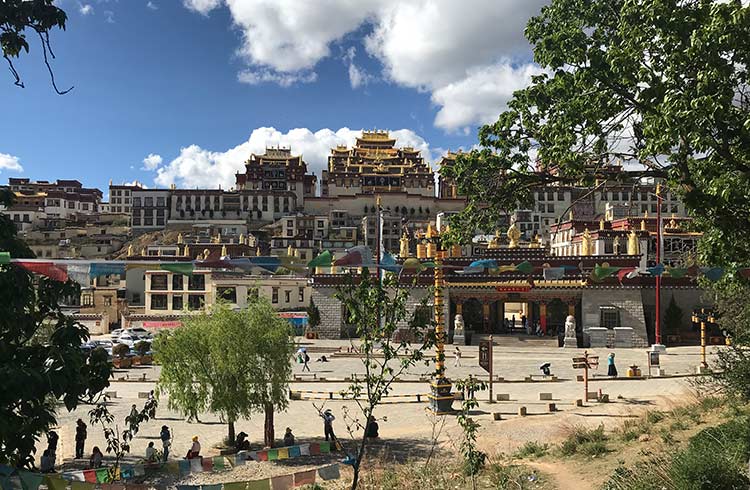
Chengdu
From Shangri-la, the 745mi (1,200km) overland route through Sichuan Tibetan areas takes in Xiangcheng, Litang, and Kangding, a journey of three days to a week to Chengdu by public bus and shared jeeps, depending on stopovers at Yading Nature Reserve and Tagong grasslands.
“Chengdu has more tea houses than sunny days,” my friend Wei tells me when we meet by Mao’s statue in Sichuan’s capital, known for its cloudy days, lazy pandas and tingly mouth-numbing peppercorn.
The Chengdu native had previously introduced me to the popular People’s Park Heming teahouse, where an acrobatic tea master deftly poured kung-fu tea from a long spout, while shoe-shiners and ear-cleaners roamed among card-playing patrons. Wei had taken me to Yuelai chaguan for afternoon masked Sichuan opera, and the incense-shrouded Wenshu temple teahouse, where we nibbled bear’s paws (thankfully vegetarian) in the shade of giant bamboo.
With the promise of a new place to try my tea, he shows me to one of the oldest surviving teahouses in China, in the town of Pengzhen just outside Chengdu.
Amidst shafts of light, illuminating faded Communist propaganda and the pipe smoke of mahjong players, Guanyinge teahouse probably has the oldest surviving men in China (some sporting blue Mao suits, sipping jasmine tea in lidded cups).
Wei breaks off a layer of my raw pu’er and pours hot water from a wicker Thermos flask, watched by a couple of octogenarians sitting beside us. I am curious to know the veteran verdict on my grassy green, slightly bitter tea, so Wei pours them steaming tumblers. A wizened 81-year-old perks up, breaks into a grin and gives the thumbs up. “Bu cuo (not bad)!”
Trip Notes
Other Places to Check Out on the Southern Silk Route
The hot springs of Tengchong, Weishan (famous for its snacks), Nuodeng, and the merchant town of Xizhou near Dali. Also, Shibaoshan grotto female organ shrine above Shaxi town, Shuhe’s Ancient Tea Horse Road Museum outside Lijiang, and one of the best hikes in China, Tiger Leaping Gorge.
Methods of Transport
While you can fly from Jinghong to Dali, Lijiang or Chengdu, the best way to experience the Tea Horse Road is overland, using day and overnight public buses. You can also catch a train between Dali and Lijiang, or hire a car and self-drive, take a private car, see it on foot by hiking, and even exploring on horseback.
Related articles
Simple and flexible travel insurance
You can buy at home or while traveling, and claim online from anywhere in the world. With 150+ adventure activities covered and 24/7 emergency assistance.
Get a quote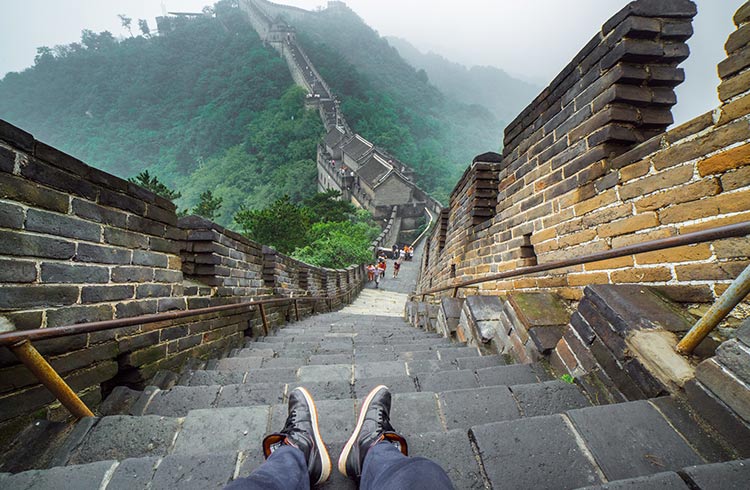
1 Comment
I have in my program for spring the tea and horse ancient road, from Ghengdu to Lhasa. Two persons or four. Private car guide and driver. Can we eventually discuss the program via mail? Thank you for your kind answer. Best regards, Paolo Georgacopulo.